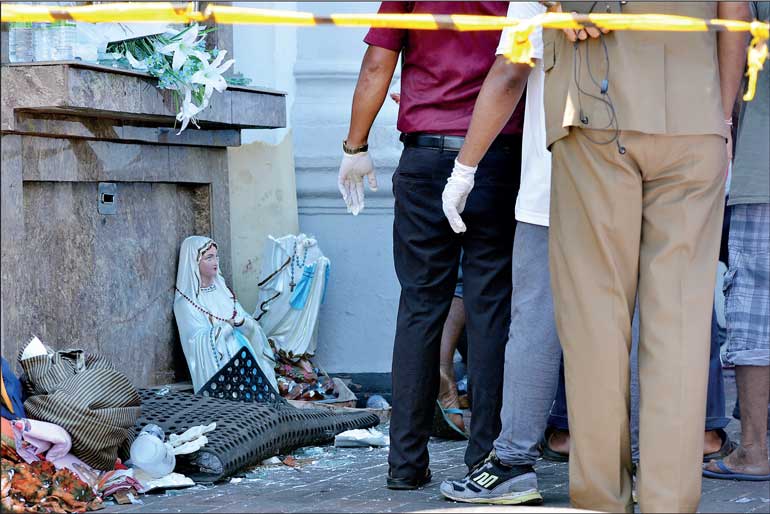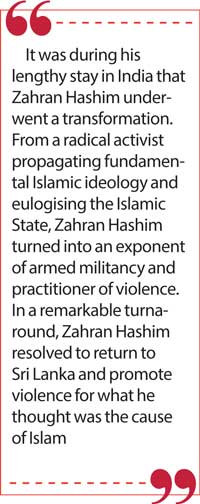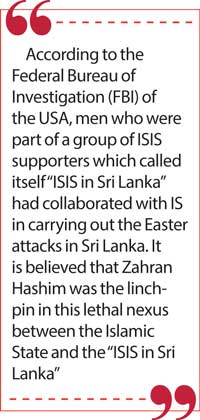Saturday Apr 19, 2025
Saturday Apr 19, 2025
Friday, 8 September 2023 00:40 - - {{hitsCtrl.values.hits}}

Those disturbing words came brutally alive when Zahran and his followers launched the Easter bombings of 21 April 2019
– Pic by Shehan Gunasekara
 Distressful memories of the Easter Sunday suicide killer bombing of churches and hotels on 21 April 2019 were revived for many this week when the British TV Channel 4 aired a documentary in its “Dispatches” program on 5 September 2023. For some of us it fanned into poignant flames, the embers of memory, regarding our friend and colleague Lasantha Wickrematunge who was brutally assassinated on 8 January 2009.
Distressful memories of the Easter Sunday suicide killer bombing of churches and hotels on 21 April 2019 were revived for many this week when the British TV Channel 4 aired a documentary in its “Dispatches” program on 5 September 2023. For some of us it fanned into poignant flames, the embers of memory, regarding our friend and colleague Lasantha Wickrematunge who was brutally assassinated on 8 January 2009.
The “revelations” made in the TV documentary by Hanzeer Azad Noulana and Nishantha Silva have alleged that the clandestine killer squad “Tripoly platoon” murdered Lasantha Wickrematunge on the purported instructions of then Defence Secretary Gotabaya Rajapaksa.
Azad Moulana is the former aide of Tamil Makkal Viduthalaip Puligal (TMVP) leader Sivanesathurai Chandrakanthan alias Pillaiyaan who is currently a state minister. Moulana said that he arranged a meeting between former military intelligence chief Suresh Salley and members of the radical Islamic movement National Thowheeth Jamaath (NTJ) in 2018. He alleged that the April 2019 bombings were done to create a climate of fear to facilitate Gotabaya getting elected as president.
Moulana claimed that after the meeting between NTJ and Salley was over “Suresh Salley came to me and told me the Rajapaksas need an unsafe situation in Sri Lanka, that’s the only way for Gotabaya to become president,” Moulana alleged that Pillayan and Salley engineered the release of NTJ from prison before he arranged for Salley to meet them. “The attack was not a plan made in just one or two days, the plan was two, three years in the making,” stated Moulana in the documentary.
Ex-police officer Nishantha Silva is the Police sleuth who probed the murder of Lasantha and interrogated Gotabaya intensively. He stated that his investigations revealed that members of the Tripoly platoon were at Lasantha’s murder scene. Both Azad Moulana and Nishantha Silva are reportedly living in Europe now having fled from Sri Lanka fearing for their safety.
Major-General Suresh Salley is currently the head of Sri Lanka’s State Intelligence Service (SIS). Gen. Salley has in a letter to Channel 4, said that the allegations against him were “outright false” and denied any contact with the individuals who spoke to the film-makers. He said he was not in Sri Lanka on the dates the alleged contact with the bombers was made. “I have no connection whatsoever in the Easter bombing,” Salley wrote. According to Channel 4 neither Pillaiyaan nor the Rajapaksa family responded to the TV’s requests for comment.
The Channel 4 film has once again drawn attention to Zahran Hashim and the National Thowheeth Jamaath. Although the documentary has only a few references and images of him, it reiterates the fact that Zahran Hashim was the “Amir” or leader of the group that was responsible for the Easter bombings.
Mohammed Zahran Mohomed Hashim known as Zahran Hashim the fiery Muslim preacher from Kattankudy in Batticaloa district was a man about whom very little was known outside of Islamic circles before the Easter Sunday bombings. Subsequently, he became well-known as the alleged mastermind behind the terror attacks on 21 April 2019. This column – with the aid of earlier writings – intends to focus on Zahran Hashim alias “Abu Ubaidah” in this article.
Kattankudy (Kaathaankudy)
Mohammed Zahran Mohomed Hashim was born in the Muslim coastal town of Kattankudy in 1985. Kattankudy pronounced in Tamil as ‘Kaathaankudy’ is situated 211 miles away from Colombo in the eastern littoral known as ‘Ezhuvaankarai’ (shore of the rising sun).
The thickly populated Kattankudy is arguably the most prosperous Muslim town in the East. It is said that Kattankudy is the busiest business centre in the Batticaloa District. The natives of Kattankudy are well-known for their entrepreneurial skills and business acumen. A very large number of leading Muslim commercial establishments in the East as well as in other areas of the island belong to people from Kattankudy.
 However, in recent times Kattankudy has acquired the hallmarks of an Arabian town. Kattankudy today is a modern township bustling with women clad in black abayas and men sporting bristling beards. Date palms are grown within urban precincts and many signboards and street arches have Arabic lettering. Kattankudy has more than 60 registered and unregistered mosques. Except for a handful, most of them are in practice influenced by Wahabi ideology.
However, in recent times Kattankudy has acquired the hallmarks of an Arabian town. Kattankudy today is a modern township bustling with women clad in black abayas and men sporting bristling beards. Date palms are grown within urban precincts and many signboards and street arches have Arabic lettering. Kattankudy has more than 60 registered and unregistered mosques. Except for a handful, most of them are in practice influenced by Wahabi ideology.
It must also be remembered that Kattankudy is the place where the LTTE in 1990 shot and killed people in four mosques while they were praying. 147 died in all. Kattankudy was affected badly by the 2004 tsunami too. 108 were killed and 93 reported missing. Some 2,000 dwellings were destroyed or damaged.
It is in this Kattankudy milieu that Zahran Hashim was born in 1985 to Hayath Mohomed Hashim and Sameema Hashim. It is said that the surname Hashim was earlier spelt as Cassim but later changed to Hashim. The family resided in the Ward 3 area in the town. Zahran was the eldest of five children. Following Zahran were two brothers Zain and Rilwan. The youngest two were sisters Madaniya and Yaseera. All of Zahran’s siblings were married with children.
Zahran Hashim himself was married in 2010. His wife Fathima Haadiya is from Kekunagolla near Narammala in the Kurunegala District. She was a student at the Kekunagolla National School when the wedding took place. They had two children, a boy and a girl. The boy was killed along with Zahran’s parents, siblings and their families at Saainthamarudhu in an explosion triggered off by Zahran’s brother. Zahran’s wife and daughter survived with injuries.
Jamiyyathul
Al-Falah Madrasa
After obtaining primary and secondary education up to GCE O/L at a government school in Kattankudy, Zahran enrolled at the Jamiyyathul Al-Falah Madrasa (Theological College) in Ward 4 of Kattankudy in 2001. He was a very bright student but soon fell foul with his teachers due to his insolence and contrarian views. Young Zahran became very fluent in Arabic and was soon attracted to fundamental Islam and Thowheedism encapsulating the ‘indivisible oneness concept of monotheism in Islam.’
Zahran Hashim became extremely rebellious at the madrasa and argued vehemently with his teachers. He also refused to abide by norms and rules. As a result, he was expelled from Al-Falah Madrasa in 2007. Had he completed his full course of studies, Zahran would have become a ‘Moulavi’ or religious scholar/teacher. But he did not and therefore was officially denied such status. In later years, many of his followers addressed him as Zahran Moulavi and Hashim did not correct them. Some of his disciples opined that Zahran had completed his studies at a school in the South.
After being ejected from the madrasa, Zahran Hashim attached himself to Sri Lanka Thowheeth Jamaath (SLTJ). Thowheeth also spelt as, Tawheed, Thawheed and Tawhid, denotes oneness with God. The Oxford Dictionary of Islam states as follows: Tawhid is the defining doctrine of Islam. It declares absolute monotheism—the unity and uniqueness of God as creator and sustainer of the universe. Used by Islamic reformers and activists as an organising principle for human society and the basis of religious knowledge, history, metaphysics, aesthetics, and ethics, as well as social, economic, and world order. Jamaath on the other hand means assembly or congregation in Arabic.
National Thowheeth Jamaath (NTJ)
Zahran Hashim initially worked with the Sri Lanka Thowheeth Jamaat (SLTJ) in Kattankudy after his madrasa studies ended abruptly. But Zahran with his ultra-radical views was soon at loggerheads with SLTJ. He then struck out on his own and formed his own organisation called National Thowheeth Jamaath (NTJ). Associated with Zahran in this venture was his one-time mentor Mohamed Ibrahim Mohamed Naufer known as Naufer Moulavi. Neither SLTJ nor its off-shoot the Ceylon Thowheeth Jamaat (CTJ) had anything to do with Zahran Hashim’s National Thowheeth Jamaath.
Although short of funds, Zahran set up a makeshift prayer centre at a wooden shed in Kattankudy and got down to work. Hashim was a very powerful orator in Tamil and Arabic. He was forcefully effective in putting his viewpoint across. Soon Zahran Hashim became a popular figure in Kattankudy. Furthermore, he was invited by Muslim devotees in different parts of the island to conduct religious lectures. Zahran Hashim travelled to many districts in Sri Lanka to address Muslim congregations. It was during the course of such visits to the North-Western Province that he met his wife Fathima Haadiya in Kekunagolla and married her. She was introduced to Zahran by Naufer Moulavi who was married to Haadiya’s aunt.
Zahran Hashim with his ultra-radical views and fiery speeches in flowery language became a magnet for young people of both sexes. He opened a Tamil website for NTJ and propagated his viewpoint. This attracted many in Tamil Nadu as well as those from Sri Lanka and Tamil Nadu who were working in gulf countries. He later operated a Facebook account on the same lines. Soon donations began to pour in.
The NTJ Mosque was now housed in a modern building at New Kattankudy – Ward 3. Although Zahran’s oratory was relished by many at meetings, not many participated in the prayers conducted at the National Thowheeth Jamaath Mosque also known as ‘Tharul Athar Athaviya.’ This may have been due to the proliferation of different mosques in Kattankudy.
Zahran Hashim also travelled around the country enrolling members for his Jamaath. The National Thowheeth Jamaath (NTJ) began to grow in strength and influence. Even as NTJ began developing into a significant entity, Zahran Hashim’s political thinking became more and more extreme. He began sympathising openly with the Islamic State of Iraq and the Levant (ISIL) and the Islamic State of Iraq and Syria (ISIS).
The turning point came in June 2014 when ISIS rebranded itself as Islamic State (IS) and announced the creation of a ‘Caliphate’ (Islamic State) erasing all State borders and making Abu-Bakr Al-Baghdadi the self-declared supreme leader of the world’s estimated 1.5 billion Muslims. Thereafter, Zahran Hashim became an avid propagandist of IS in Tamil. He kept posting news items about IS battlefronts in Tamil and also wrote opinion pieces in support. Zahran Hashim was seen as the voice of IS in some Muslim circles.
Baduriya Mosque
Everything seemed hunky-dory for him but Zahran Hashim got into trouble by overreaching himself. To most Wahabi influenced Muslims in Kattankudy, the Baduriya Mosque at the Aliyar Junction in Ward 6 is anathema. This is because Baduriya Mosque adheres more to mystical Islam known as ‘Sufism’ and adopts practices such as paying homage to saints and indulging in grave worship. Wahabis regard this as blasphemous and heretical.
So in an ill-advised bid to teach a lesson to Baduriya Mosque people, Zahran Hashim organised a NTJ meeting at the Aliyar Junction in close proximity to the mosque. When the meeting commenced on 16 March 2017, speaker after speaker made insulting references to Baduriya Mosque. The intention was to provoke Baduriya Mosque devotees. Zahran Hashim had brought clubs and swords clandestinely to the venue and kept them concealed on the stage. As expected, Baduriya Mosque devotees were provoked by the insults and retaliated by pelting stones at the stage. Zahran Hashim and his followers then set upon their rivals and attacked them with swords and clubs.
In the clash that ensued several persons on both sides were injured. Three sustained serious injuries and were hospitalised. The people of Kattankudy were incensed at the violence done in the name of religion. A protest demonstration organised by the Baduriya Mosque management opposite the Kattankudy Islamic museum was well attended. There was tremendous pressure on the police to take action. As a result, nine from NTJ Mosque and two from Baduriya Mosque were arrested and remanded for several months. These included Zahran’s brother Zain. Zahran himself was wanted by the police. He chose to evade arrest by absconding. A story was spread in Kattankudy that Hashim had gone to the Maldives.
There was also suspicion among some Muslim circles that Zahran and his National Thowheeth Jamaath were being clandestinely financed by Sri Lankan “intelligence”. This suspicion was reinforced when two policemen were killed in November 2018 at Vavunatheevu in Batticaloa. It may be recalled that the then Cabinet spokesman Dr. Rajitha Senaratne had disclosed that four military intelligence operatives had coordinated the killings of the two cops in Vavunatheevu. The minister also alleged that 26 members of the National Thowheeth Jamaath had been on the payroll of Military intelligence when Mahinda Rajapaksa was president and his brother Gotabaya the defence secretary.
Tamil Nadu and Kerala
 Zahran Hashim left Kattankudy and moved to the North-Western Province from where his wife hailed. After spending some time in Sri Lanka, Zahran relocated to India where he began interacting with Muslim extremist groups in the South Indian States of Tamil Nadu and Kerala. His sojourns were mostly in the Malappuram District of Kerala and the Coimbatore, Trichy, Thirunelvely, Vellore, Nagapattinam, Kanniyakumari and Ramanathapuram Districts of Tamil Nadu. All these districts have sizeable Muslim populations.
Zahran Hashim left Kattankudy and moved to the North-Western Province from where his wife hailed. After spending some time in Sri Lanka, Zahran relocated to India where he began interacting with Muslim extremist groups in the South Indian States of Tamil Nadu and Kerala. His sojourns were mostly in the Malappuram District of Kerala and the Coimbatore, Trichy, Thirunelvely, Vellore, Nagapattinam, Kanniyakumari and Ramanathapuram Districts of Tamil Nadu. All these districts have sizeable Muslim populations.
It was during his lengthy stay in India that Zahran Hashim underwent a transformation. From a radical activist propagating fundamental Islamic ideology and eulogising the Islamic State, Zahran Hashim turned into an exponent of armed militancy and practitioner of violence. In a remarkable turnaround, Zahran Hashim resolved to return to Sri Lanka and promote violence for what he thought was the cause of Islam.
Jamaate Millat Ibrahim (JMI)
After returning to Sri Lanka Zahran began cultivating links with rich and educated supporters of the Islamic State (IS). The aim was to enlist more volunteers to go to the Middle-East and fight for the IS. But the anti-Muslim violence in Amparai town in February 2018 and the Kandy District anti-Muslim violence of March 2018 made him change his mind. Zahran now wanted to attack a symbolic target like the Ruwanweliseya in Anuradhapura or the Esala Perahera in Kandy. New members were recruited, arms and explosives collected and arms training workshops held. This re-invigorated extremist fervour caused a split in the NTJ. Zahran and his militant disciples broke away and began functioning as the extremely militant Jamaate Millat Ibrahim (JMI) group.
At some point of time, Zahran supposedly influenced by Naufer Moulavi put on hold his plans of attacking “Buddhist” targets. Instead he opted to take on the “Christian West”. It is presumed that Hashim thought this would grab worldwide attention and help ingratiate himself further with the Islamic State. Thus churches and luxury hotels catering mainly to Western tourists were selected as targets.
Islamic State (IS)
The Islamic State (IS) objective of eliminating or subjugating the “Kaffirs” (non-believers/infidels) and establishing a world-wide Islamic “Calpihate” was something which Zahran embraced wholeheartedly.
I have seen some video clips of Zahran’s speeches. They were very powerful spectacles of persuasive oratory of inhuman nature. He referred to the Christians as “Siluvai Vanangihal” (worshippers of the cross) and Hindus and Buddhists as “Silai Vanangihal” (worshippers of statues). While calling for the destruction of “Kaffirs”, Zahran emphasised one point strongly. He said that even if the Kaffirs were good people who were friendly and helpful towards Muslims, they had to be destroyed when necessary.
Those disturbing words came brutally alive when Zahran and his followers launched the Easter bombings of 21 April 2019. Two Catholic Churches, three upmarket tourist hotels and an Evangelical Church were targeted in Colombo, Negombo and Batticaloa in the morning. Suicide bombers with explosives strapped to their bodies exploded themselves while worship was going on in churches and breakfast was being partaken of in hotels. 269 people were killed and over 500 injured as a result of that “bloody” Easter Sunday. As mentioned earlier it is suspected that the Islamic State (IS) persuaded Zahran into attacking hotels and churches. It is also believed Naufer Moulavi played a part in influencing Zahran.
“Islamic State fighters”
Two days after, the international ‘Jihadist’ or Islamic militant movement known officially as Islamic State (IS) claimed responsibility for the terror and horror of ‘bloody’ Easter in Sri Lanka. It attributed the attacks to “Islamic State fighters”. A few days later in April 2019, the then-leader of ISIS Abu-Bakr Al-Baghdadi praised the attackers for what he called retaliation against “the West” for defeating ISIS the previous month in Baghuz, Syria.
The IS, known earlier as Islamic State of Iraq and the Levant (ISIL) and Islamic State of Iraq and Syria (ISIS), aimed at establishing a worldwide ‘Caliphate’ or a single Islamic government. In 2014, the IS controlled extensive swathes of territory in Iraq and Syria. Subsequently, the areas held by IS shrank greatly, thanks to the military defeats inflicted by the US-led coalition of forces.
According to the Federal Bureau of Investigation (FBI) of the USA, men who were part of a group of ISIS supporters which called itself “ISIS in Sri Lanka” had collaborated with IS in carrying out the Easter attacks in Sri Lanka. It is believed that Zahran Hashim was the linchpin in this lethal nexus between the Islamic State and the “ISIS in Sri Lanka”.
“Abu Ubaidah”
Zahran Hashim alias ‘Abu Ubaidah’ was one of the two suicide bombers who targeted Shangri-La Hotel at Galle Face. A media release by the Aamaq news agency on behalf of the Islamic State (IS) revealed that Zahran had adopted the nom de guerre “Abu Ubaidah” in the IS.
Abu Ubaidah refers to Abu Ubaidah Amir ibn Abdillah ibn al-Jarra who was one of the 10 prominent companions of Prophet Muhammad. He later served as a commander of the Rashidun Army under Caliph Umar. Abu Ubaidah, credited with several military victories, was hailed then as the “commander of all commanders.
(The writer can be reached at [email protected].)
Discover Kapruka, the leading online shopping platform in Sri Lanka, where you can conveniently send Gifts and Flowers to your loved ones for any event including Valentine ’s Day. Explore a wide range of popular Shopping Categories on Kapruka, including Toys, Groceries, Electronics, Birthday Cakes, Fruits, Chocolates, Flower Bouquets, Clothing, Watches, Lingerie, Gift Sets and Jewellery. Also if you’re interested in selling with Kapruka, Partner Central by Kapruka is the best solution to start with. Moreover, through Kapruka Global Shop, you can also enjoy the convenience of purchasing products from renowned platforms like Amazon and eBay and have them delivered to Sri Lanka.
Discover Kapruka, the leading online shopping platform in Sri Lanka, where you can conveniently send Gifts and Flowers to your loved ones for any event including Valentine ’s Day. Explore a wide range of popular Shopping Categories on Kapruka, including Toys, Groceries, Electronics, Birthday Cakes, Fruits, Chocolates, Flower Bouquets, Clothing, Watches, Lingerie, Gift Sets and Jewellery. Also if you’re interested in selling with Kapruka, Partner Central by Kapruka is the best solution to start with. Moreover, through Kapruka Global Shop, you can also enjoy the convenience of purchasing products from renowned platforms like Amazon and eBay and have them delivered to Sri Lanka.